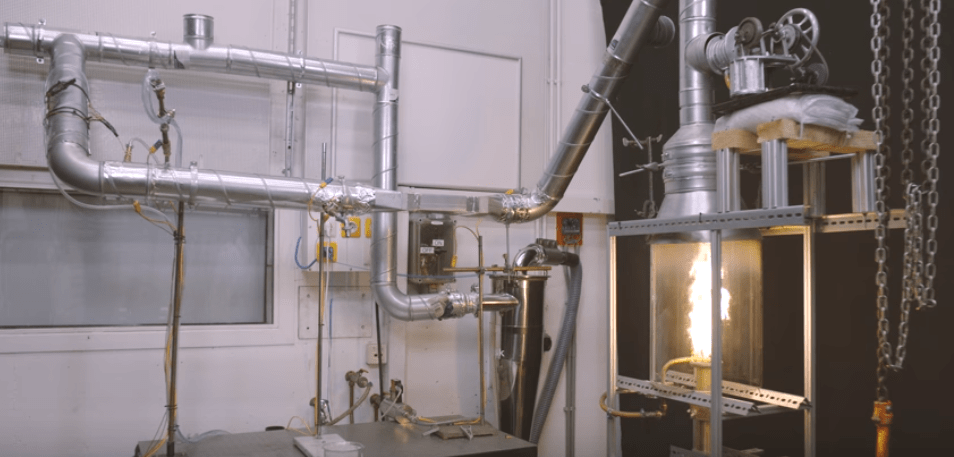
Replacing coal in a coal-fired power station with more sustainable iron powder is the goal on which TU/e, Team SOLID, the province of North Brabant and Metalot are working together. Within the Metal Power project, they want to further develop a system for energy storage via metal. The demonstration system that will be tested at a Brewery will be ready by mid-2019.
TU/e has been researching the foundations of metal fuels for several years now and the student team SOLID recently built a test system in which iron powder is burned. With the heat that is released, steam is made. The burnt iron powder, rust powder, is captured. “What we do is one part of the circular process,” explains Geert Vergoossen, chairman of the SOLID team. The rust powder that is captured is used to make iron powder by blowing hydrogen through it. “The hydrogen particle then goes back to the oxygen particle, which in turn produces iron.” According to Vergoossen, for that reason, it is a circular system that no longer uses CO2. Energy can also be stored for a long time in the iron powder. “You have almost no loss due to a leak or battery drain.”
Demonstration system
The first goal within the Metal Power project is to scale-up the test system to a 100-kilowatt demonstration system at the Metalotcampus in Cranendonck. Philip de Goey, project leader, professor at TU/e and chairman of Metalot3C, Metalot’s innovation centre, sees a rapid scaling-up ahead of him. “With this demonstration system, we want to show that large-scale combustion of metal powder, iron powder in this case, is possible.”
After the 100-kilowatt demonstration system, De Goey wants to make the system larger, step by step. “For a hundred kilowatts, one has to think of the capacity to drive a few cars. But we are now working with Shell to increase this capacity ten times over. That’s one megawatt and that’s enough energy for a small neighbourhood.”
Ultimately, the idea is that iron powder can replace the coal in a coal-fired power station. “We’re going to do that in steps. If we can show the system at one megawatt, we will, of course, encounter problems that we would probably also encounter on a larger scale. That way we can solve those problems before the system really works in a coal-fired power station,” says De Goey. Uniper has a coal-fired power station on the Maasvlakte and is investing in this project in order to be able to replace their coal with iron powder in the future. “They are also looking for new ways to generate energy and see a lot of potential in this project,” explains De Goey.
Brewery
The heat used in industry consists largely of steam. Therefore, the demonstration system will first be connected to a Dutch brewery. “After that, we will do extensive tests on the Metalot campus”, explains De Goey. “For example, we will try different iron powders. All these tests are to see when the system works properly and when it doesn’t.” Building the demonstration system and testing the possibilities of burning iron powder on a large scale instead of coal will take about two years. That concludes the Metal Power project. “We also hope to build a one-megawatt demonstration system during this project,” says De Goey. Whether that will succeed remains to be seen.
Metal fuels
Metal fuels are one of the materials used to reduce CO2 emissions. In addition to iron powder, many people around the world are also looking at the possibilities of formic acid, electricity and hydrogen gas. According to De Goey, the latter two are not very promising for replacing coal-fired power stations. “Electricity could only be stored in enormous batteries. That is far too big and too heavy. And hydrogen gas is more difficult to store over the long term and has much more volume. That’s why it takes up too much space,” he says. “Iron powder is safe and compact. That’s why it’s more suitable.”
Cooperation
“I think it’s very good that so many different parties are involved in this project,” says Vergoossen of team SOLID. “As a student team, we can make things very quickly and we are very flexible. The engineering companies involved have a lot of knowledge and experience in making these kinds of systems. How and where you are going to apply such a system and what the importance is within a sustainability transition, is where the province comes into play.” According to him, the support of these parties and the involvement of the companies are desperately needed. “Different elements of the system come from different companies. So all these companies have to adapt their systems, otherwise, we cannot make a comprehensive product”, says Vergoossen.
According to him, this is also reflected in the composition of the student team. “We have a multidisciplinary team that works very well. Everyone has different expertise and can, therefore, offer a different perspective around a problem or the solution,” says Vergoossen. He also believes that a student team has a ‘healthy portion’ of naivety. It is a group of capable and motivated students who are eager to achieve something. “We have no commercial purpose. That means that other companies are also very friendly to us.” Especially not thinking about commercial goals has added value within such cooperation. “Our vision has not yet been ruined by money or old thoughts. That makes us a bit naive, but it does mean that we can really achieve something.”
Goal
The ultimate goal of the TU/e and the student team is to create an ecosystem for metal fuels as a circular energy carrier. According to them, the demonstration system is a step in that direction. “We believe it is important to connect as many companies as possible that support the technology. Then technology can certainly become a success,” explains Vergoossen. “The most important thing for us is that as many parties as possible contribute to the development.”

